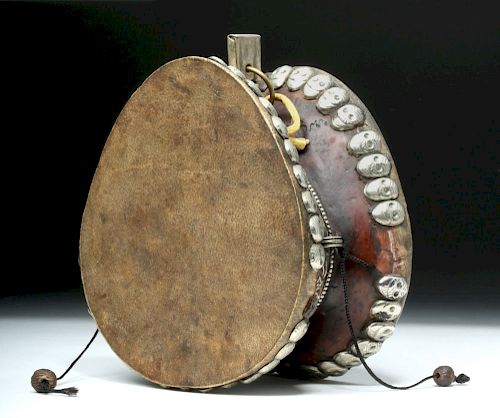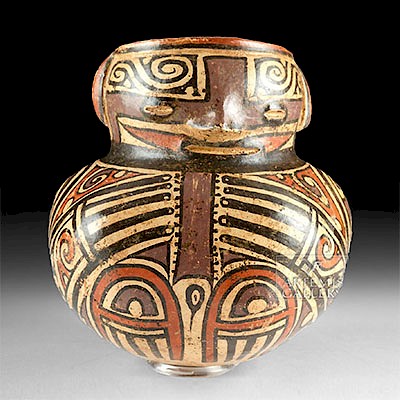19th C. Tibetan Double Skull and Skin Damaru - Drum
Lot 45b
About Seller
Artemis Fine Arts
686 S Taylor Ave, Ste 106
Louisville, CO 80027
United States
Selling antiquities, ancient and ethnographic art online since 1993, Artemis Gallery specializes in Classical Antiquities (Egyptian, Greek, Roman, Near Eastern), Asian, Pre-Columbian, African / Tribal / Oceanographic art. Our extensive inventory includes pottery, stone, metal, wood, glass and textil...Read more
Categories
Estimate:
$2,000 - $3,000
Absentee vs Live bid
Two ways to bid:
- Leave a max absentee bid and the platform will bid on your behalf up to your maximum bid during the live auction.
- Bid live during the auction and your bids will be submitted real-time to the auctioneer.
Bid Increments
| Price | Bid Increment |
|---|---|
| $0 | $25 |
| $300 | $50 |
| $1,000 | $100 |
| $2,000 | $250 |
| $5,000 | $500 |
| $10,000 | $1,000 |
| $20,000 | $2,500 |
| $50,000 | $5,000 |
| $100,000 | $10,000 |
| $200,000 | $20,000 |
About Auction
By Artemis Fine Arts
Nov 8, 2018
Set Reminder
2018-11-08 10:00:00
2018-11-08 10:00:00
America/New_York
Bidsquare
Bidsquare : Ancient / Ethnographic From Around The World
https://www.bidsquare.com/auctions/artemis-gallery/ancient-ethnographic-from-around-the-world-3598
Ancient art from Egypt, Greece, Italy and the Near East, as well as Asian, Pre-Columbian, Native American, African / Tribal / Oceanic, Spanish Colonial, Russian Icons, Fine art, much more! Artemis Fine Arts info@artemisfinearts.com
Ancient art from Egypt, Greece, Italy and the Near East, as well as Asian, Pre-Columbian, Native American, African / Tribal / Oceanic, Spanish Colonial, Russian Icons, Fine art, much more! Artemis Fine Arts info@artemisfinearts.com
- Lot Description
Central Asia, Tibet, ca. 19th century CE. A two-headed drum, known as a damaru (damru), made from two skull caps that are held together by a strip of silver that is folded around their upper portions, its ends folded together to form a handle. This silver strip is in repousse, decorated with repeated motifs of stars and vines, terminating in a silver cap around the end of the handle. Opposite the handle, on the silver strip, are three projecting inlays, two of which remain, both round glass beads, one turquoise colored, the other red. These may be a replacement for actual turquoise and coral (common Tibetan decorative elements). This is pierced through with a brass ring that may be later than the rest of the piece. The "leather" drum heads - made from human skin - are held in place by studded silver skulls, tightly pressed together to form a border around the rim. Size: 5.3" L x 4.75" W x 3" H (13.5 cm x 12.1 cm x 7.6 cm)
Two loops are attached to the silver central strip, with strings hanging from them that have small nuts on the ends and provide a nice noise when swung. The damaru drum is used in both Tibetan Buddhism and Hinduism, and in the former it is used in tantric practices as just one of the sacred implements that form their rituals. Traditionally these items are made from a male and a female skull joined at their apex. Although we cannot see inside without destroying the skin, they are often inscribed with mantras in gold. They are often played with the right hand, accompanied by a bell in the left hand.
Provenance: private Santa Fe, New Mexico, USA collection
All items legal to buy/sell under U.S. Statute covering cultural patrimony Code 2600, CHAPTER 14, and are guaranteed to be as described or your money back.
A Certificate of Authenticity will accompany all winning bids.
We ship worldwide and handle all shipping in-house for your convenience.
#125673Beautiful dark patina on surface, especially on bone. One of the drum heads is ripped. One inlaid stone is missing. Approximately ten of the small silver skulls around the two rims are either missing or have been replaced with non-silver alternatives.Condition
- Shipping Info
-
All shipping is handled in-house for your convenience. Your invoice from Artemis Gallery will include shipping calculation instructions. If in doubt, please inquire BEFORE bidding for estimated shipping costs for individual items.
-
- Buyer's Premium



 EUR
EUR CAD
CAD AUD
AUD GBP
GBP MXN
MXN HKD
HKD CNY
CNY MYR
MYR SEK
SEK SGD
SGD CHF
CHF THB
THB

















